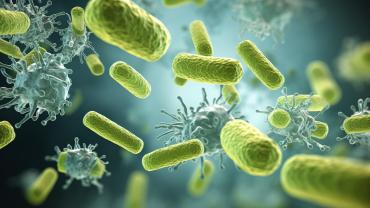
The body utilizes two critical pathways to maintain nitric oxide (NO) production to promote normal blood pressure and flow, among other vital functions. The first pathway of NO production requires the precursor amino acid L-arginine and a healthy structure and function of the vascular endothelium. Unfortunately, the activity and function of this pathway can decline with age or in cases of certain metabolic conditions. Unlike the first pathway, the second pathway, called the “enterosalivary pathway,” does not decline with age but requires two necessary elements: dietary intake of nitrates through food or supplements and a healthy oral microbiome. This is relevant to the general population as clinical studies suggest impaired NO production, activity, or bioavailability is associated with endothelial dysfunction in cardiovascular disease, hypertension, hyperlipidemia, and diabetes mellitus.
A quick review of the oral microbiome’s role in NO production
The enterosalivary pathway starts when an exogenous source of inorganic dietary nitrate is digested through nitrate-rich foods, such as beets and green, leafy vegetables. The gastrointestinal tract rapidly absorbs nitrate, where it enters circulation, and ~25% is transported to the saliva glands, forming salivary nitrate.
The subsequent crucial step involves the reduction of salivary nitrate to nitrite by nitrate reductases found in certain commensal oral bacteria, such as Rothia mucilaginosa, Haemophilus parainfluenzae, Neisseria flavescens, and Neisseria subflava. The saliva containing nitrite is swallowed and reduced to NO in the stomach, where it enters circulation and provides clinical benefits.
Therefore, a healthy oral microbiome is vital for proper NO conversion through the enterosalivary pathway. Even with ample dietary nitrate intake, this pathway would only succeed with commensal oral bacteria reducing nitrate into nitrite.
Healthy blood pressure and the oral microbiome
Due to NO’s role in healthy blood circulation, researchers have found an association between an unhealthy oral microbial environment with the potential influence on the development of unhealthy blood pressure. In the last decade, various studies have explored the effects of antibacterial mouthwashes on NO production and, subsequently, healthy blood pressure. Chlorhexidine is the most widely studied antibacterial agent in mouthwashes. Joshipura et al. postulates that, as approximately 99% of mouthwash contains an antibacterial agent, any type/brand can potentially harm nitrate-reducing bacteria. However, further research is needed on other over-the-counter mouthwashes as their effects are unknown.
In one randomized controlled crossover trial, 15 treated hypertensive individuals (mean age 65 years) received antibacterial mouthwash (containing chlorhexidine) or a control for three days. After receiving mouthwash, the subjects displayed a significant decrease in oral nitrate to nitrite reduction (P = 0.02), decreased salivary nitrite (P = 0.01), and increased salivary nitrate (P < 0.001) compared to the control. There was a trend toward a decrease in plasma nitrite concentration (P = 0.09), though this did not reach statistical significance. Over the three days, the group using the antibacterial mouthwash also experienced higher systolic blood pressure (2.3 mmHg), but no increase in diastolic blood pressure. No effect was observed for plasma cyclic guanosine monophosphate (cGMP, a marker of NO production) relative to control.
A crossover study with 19 healthy volunteers was performed using an initial 7-day control period, followed by a 7-day treatment period with chlorhexidine-based antiseptic mouthwash. After the mouthwash period, oral nitrite production was reduced by 90% (p < 0.001) and plasma nitrite levels by 25% (p = 0.001) compared to the control period. Moreover, systolic and diastolic blood pressure increased by 2 to 3.5 mmHg, correlating to a decrease in circulating nitrite concentrations. Interestingly, the rise in blood pressure appeared within the first day of mouthwash use and was sustained during the seven days. This intervention was not randomized or placebo-controlled.
While these two studies are relatively small, a longitudinal study with 540 participants (free of hypertension at baseline, overweight or obese, and between 40 and 65 years old) took place for three years to observe the association between regular use of over-the-counter mouthwash and hypertension. The researchers concluded that, independent of major risk factors for hypertension and several other potential confounders (including dietary factors), people who used mouthwash twice or more daily at baseline had an 85% higher risk of being diagnosed with hypertension compared to less frequent users and more than double that of non-users. They did not limit mouthwash brands or types or disclose the antibacterial agents used by the participants, necessitating further research on clinical applications.
Conclusion and clinical insights
Evidence suggests that promoting oral health and a healthy oral microbiome can help support more than just dentistry. The role of the oral microbiome in NO production is an exciting new avenue in potentially supporting overall cardiovascular health. As daily assessment of the oral microbiome’s health may be challenging, NO oral test strips can be used to monitor the presence of nitrate-reducing probiotics in the oral microbiome and dietary nitrate intake. Daily monitoring can help guide individuals in positively modifying their dental hygiene routine, increasing dietary nitrates intake through foods or supplements, or both.
Explore more ways to promote oral health:
Purified Silver for Oral Health
MCT Oil and Periodontal Wellness
The Latest on Probiotics and Periodontal Health
By Danielle Moyer Male, MS, CNS, LDN